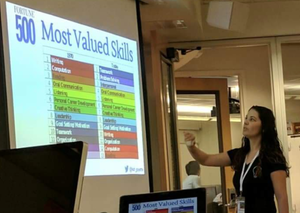
Andragogy – Pedagogy for Adults
We often hear educators discuss the importance of research based, effective pedagogy for our students. Coaches and administrators ask teachers to actively engage students, personalize learning, and design experiences for students to construct knowledge through exploration. Sadly, these well-meaning adults may plan staff meetings and professional development sessions in which adult learners are subjected to sit-and-get, lecture style experiences that fail to personalize the new learning to their levels of prior knowledge and particular context. What about pedagogy for professional development? What does the research say about the most effective way to reach adult learners? Andragogy is the study of theory and practice regarding methods of teaching adult learners. In accordance to Knowles’ theories of andragogy, adults learn best when they:1) know why they are learning something2) learn experientially3) approach learning as problem-solving4) learn best when there is immediate value
Starting with “Why”
With these principles in mind, I aim to craft personalized professional development sessions that meet the specific needs of adult learners. What does this look like in practice? We begin with the “why“. I typically introduce the why by sharing a few images, facts, and/or compelling videos illustrating the world our students are living in, and the need for us to adapt to their needs in order to prepare students for the modern world. In the image below, educators view the skills most valued by fortune 500 companies in 1970, and in the 21st century.

Next, we contextualize this “why” so that it is memorable and easily aligns to educators’ instructional lens. Through collaborative conversations, educators come to the realization that engaging students in the 4 Cs (Communication, Collaboration, Creativity, Critical Thinking) fosters an environment that prepares students for college and career. The 4 Cs are woven through state, national, and international standards.
Experiential Learning
We must provide our adult learners an opportunity to experience learning in a way that meets a range of proficiency levels and allows for professional autonomy. In the example below, rather than subjecting educators to sit and get PD, I trusted teachers to explore a multitude of resources, based on their curiosity.

Educators view resources and/or visit stations to learn on their own alongside their colleagues, according to the topics that are most applicable to them individually. This provides immediate value.

As seen above, a launch presentation contains hyperlinks to varied slidedecks for exploration based on specific topics that may be of interest to educators. A needs/interest assessment given to learners ahead of time helps determine which slidedecks will be included. Each slidedeck contains tutorials and hyperlinks to additional resources, for a personalized, rabbit-hole learning adventure. This open-ended approach naturally differentiates for technological proficiency, context of grade levels and content, and empowers teachers to create 4 Cs infused lessons based on their learnings. If so desired, educators can use the comments feature in Google Slides within the launch presentation to share what they notice and wonder about the resources. This allows the facilitator(s) of learning to receive formative feedback to better meet the needs of educators.
Learning Facilitator Cloning
While it took me time and thought to prepare an experiential learning adventure as seen above, the results outweigh this commitment. As I watched teachers engage with the resources via the exploratory slidedeck, I saw myself cloned again and again as they viewed video tutorials I had made via screencasting.

Collaborative Problem-Solving

Following exploration via rabbit-hole styled personalized learning, I invite educators to work collaboratively to solve a problem – the challenge of how to connect their learning to the “why”, the 4 Cs. This activity grounds the learning in context of instructional practice and allows educators to learn from each other. Teachers share their learnings and discuss 4 Cs application within their teams and then with the entire group of adult learners (via whole group share-out and/or gallery walk with notice and wonder post-its). During this process, educators engage in collaborative conversations that often sparks innovative ideas and builds relational trust.
Immediate Application
Learning is sustained whence it is applied immediately. In the photo below, educators use Google Classroom as a “student” as they infuse their new learnings to instructional planning. Screenshots with arrows and circles are provided as scaffolds for teachers unfamiliar with using Google Classroom as a platform.


Adult learners experience technology integration as a “student”, thereby learning by doing. A 4 Cs lesson plan template is provided to educators via Google Classroom, where they begin to plan a standards based lesson that infuses their new learning from the exploration slidedecks. New learnings are highlighted, and the open-ended lesson plan template allows for professional autonomy but retains the context of the “why”, the 4 Cs. As educators focus on engaging students in the 4 Cs, they focus on student learning rather than teacher instruction. The focus shifts from what the teacher is doing, to how the students will engage in the 4 Cs. Thereby, andragogical principles lead to pedagogy that prepares students for the world of today and the unpredictability of tomorrow.
